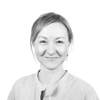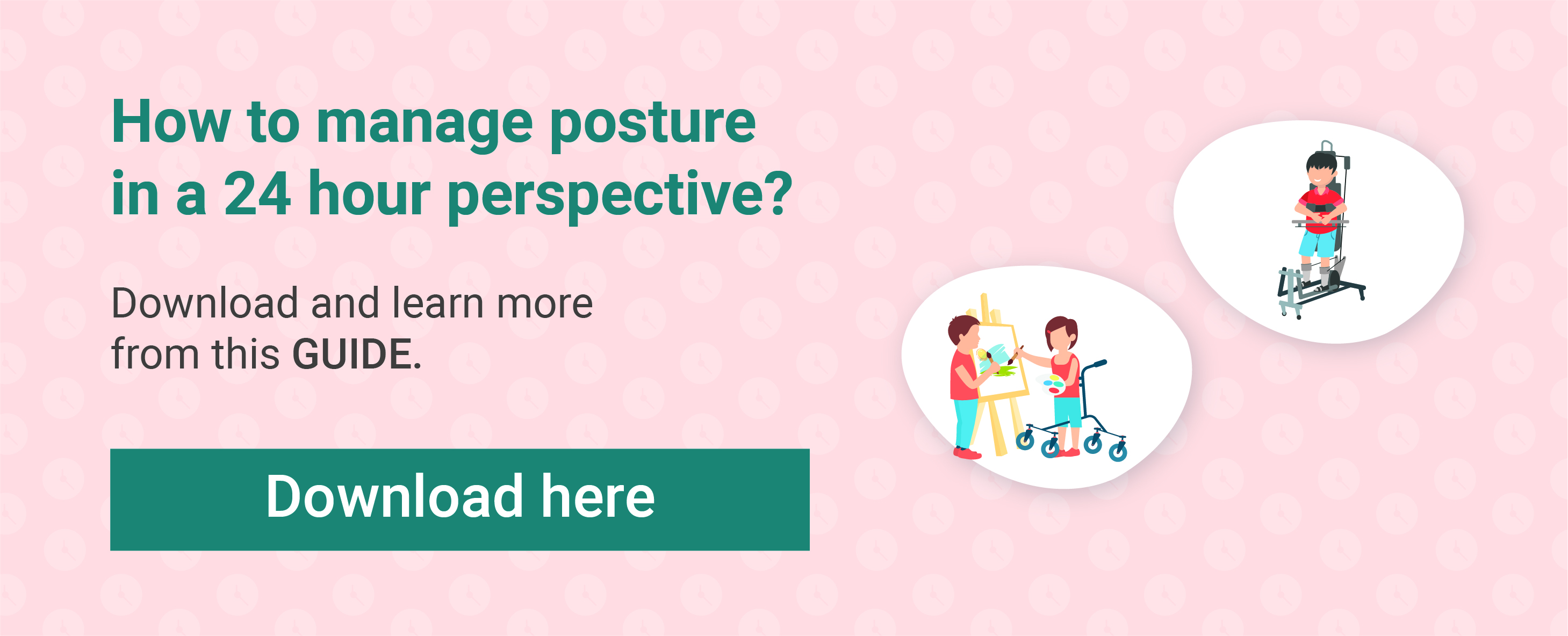
Nov 19, 2025Scoliosis in children with cerebral palsy

Back to Blog Overview
Scoliosis is a common orthopaedic challenge for children with cerebral palsy, often making it difficult for families to understand and manage. Changes in muscle tone, posture, and movement place extra stress on the spine, hips, and pelvis as a child grows, making early awareness and monitoring essential.
In this article you can read about:
- What is scoliosis and why does it happen in CP?
- How common is it and who is most at risk?
- How hips and spine affect each other
- How scoliosis can affect comfort, breathing, and daily life
- Monitoring and early intervention
- What early monitoring looks like in practice
- What this means for you as a parent
- Treatment options
What is scoliosis and why does it happen in CP?
Scoliosis means that the spine curves sideways instead of being straight. Children with cerebral palsy have significant risk of developing scoliosis and it is thought to be associated with:
- Muscle weakness
- Spasticity
- Poor trunk and muscle control
These factors can cause the spine to bend or twist, especially as your child grows. The curve may start small but can gradually increase.
How common is it and who is most at risk?
Scoliosis is relatively common in children with CP, but the chances of developing it vary depending on each child’s movement abilities, posture, and daily positioning.
Children at GMFCS levels IV and V, who have more difficulty sitting or walking independently, are at higher risk of developing scoliosis. This increased risk is mainly due to:
- Reduced trunk control
- Limited variety of movement throughout the day
- Difficulty maintaining an upright posture
These factors make the spine more vulnerable to curving over time, especially during periods of growth.
Other factors that may increase the risk include:
- Rapid growth spurts during puberty
- Weak trunk control or uneven muscle tone
- Hip displacement or pelvic tilt
- Poor or inconsistent seating support
Gross motor function classification system(GMFCS)
To better understand why some children are more at risk, it helps to know how mobility is classified in cerebral palsy. The Gross Motor Function Classification System (GMFCS) describes how children move and function in everyday life — at home, at school, and in their community.
It focuses on what the child does regularly, not their best or most difficult moments.
Children are placed into one of five levels, described across age bands (under 2, 2–4, 4–6, 6–12, and 12–18 years). Below is a summary of the levels for children aged 6–12 years:
GMFCS I
Walks independently in all settings and climbs stairs without using a railing.
GMFCS II
Walks in most settings and uses a railing when climbing stairs.
GMFCS III
Uses a hand-held mobility device indoors and may climb stairs with assistance and a railing.
GMFCS IV
Requires physical assistance or powered mobility for most movement in daily settings.
GMFCS V
Is transported in a manual wheelchair in all settings, with significant challenges in head, trunk, and limb control.

How hips and spine affect each other
The hips, pelvis, and spine work as a team to help the body stay upright and balanced. When one part becomes uneven or strained, the others usually try to compensate. In children with cerebral palsy, this relationship can become unbalanced, leading to a pattern of changes that affect posture, sitting, comfort, and mobility.
Many children with CP develop hip displacement, where the ball of the hip joint gradually moves out of the socket. When this happens on one side more than the other, it can cause the pelvis to tilt, a condition known as pelvic obliquity (PO).
Research shows that hip problems are a major contributor to pelvic tilt. When the pelvis tilts, the spine must curve to keep the body upright. This can lead to scoliosis — often bending away from the high side of the pelvis as the spine tries to find balance.
The influence also goes the other way. If scoliosis develops first, especially a curve involving the lower spine:
- It can pull the pelvis out of alignment.
- The child may sit more heavily on one side, increasing pressure on one hip.
- Over time, this uneven loading can worsen hip displacement.
How scoliosis can affect comfort, breathing, and daily life
Scoliosis isn’t just about how the spine looks — it can affect how your child feels and functions every day.
As the curve becomes larger, it can:
- Make sitting or positioning difficult
- Cause back or hip pain
- Limit breathing capacity in severe cases
- Make personal care or dressing more challenging
Monitoring and early intervention
Early monitoring is one of the most powerful tools we have to prevent scoliosis or slow its progression in children with cerebral palsy. Several surveillance programs for CP have documented this, such as the Swedish CPUP program (Cerebral Palsy Follow-Up Program). It is one of the world’s best examples of how systematic, long-term follow-up can protect children’s hips, spine, and overall musculoskeletal health. Its success provides clear guidance on how to identify scoliosis early and intervene before curves become severe or fixed.
Although CPUP’s strongest documented effect is its reduction in hip dislocation—from around 10% to just 0.4%—this is correlated to scoliosis.
Hip displacement, pelvic asymmetry, and trunk posture are closely linked. Keeping hips well-positioned provides a more stable, symmetrical base for the spine.
Early identification is key, meaning that children should enter monitoring programs as early as possible. Early findings—especially at the hips and pelvis—often appear before scoliosis becomes noticeable.
What early monitoring looks like in practice
CPUP from Sweden provides a practical blueprint for early scoliosis prevention. The following principles can be adapted in any clinical setting:
Regular clinical examinations
Children receive routine assessments of:
- posture in sitting and standing
- spinal alignment, including forward-bending tests
- trunk symmetry
- muscle tone and balance
If any changes appear, follow-up is increased or imaging is carried out.
Radiographic monitoring when indicated
For children who show signs of asymmetry or are at higher risk (typically GMFCS III–V), X-rays are performed at specific intervals to detect early spinal curvature or hip displacement.
Tracking functional level with GMFCS
A child’s GMFCS level guides:
- how often they should be assessed
- which preventive strategies are most relevant
- when to involve orthopaedic specialists
Children with higher GMFCS levels benefit most from closer and more frequent follow-up.
Early follow-up of the hips and pelvis
Because hip issues and pelvic obliquity often appear before scoliosis:
- hip range of motion (especially abduction)
- hip migration percentage (MP) on X-ray
- pelvic alignment in different positions are evaluated regularly.
A Strong interdisciplinary team
Prevention is most effective when physiotherapists, occupational therapists, orthopaedic surgeons, and the child’s multi-disciplinary team work together. Small changes are easier to address when everyone is watching for early signs.
Standardised measurement tools
The use of consistent, validated measurement protocols. This makes it easy to track even slight changes and adjust treatment plans right away.
Focus on everyday life
Prevention doesn’t happen only in clinics. Daily life matters:
- supported, symmetrical sitting
- proper wheelchair and seating adjustments
- opportunities for varied positions (sit–stand–lie)
- maintaining muscle length and flexibility
Families, schools, and therapists work together to create supportive routines.
What this means for you as a parent
If your child participates in a program modelled on CPUP—or any structured surveillance system—there is real potential to catch scoliosis early and prevent complications long before they become severe.
Here’s what you can do:
Stay Alert for Early Signs
Watch for:
- reduced movement in the hips
- your child leaning to one side
- uneven sitting posture
- changes in how clothes fit
- stiffness or discomfort in certain positions
These signs should be shared with your therapy team.
Support Good Posture and Positioning
At home and in school:
- ensure proper seating support
- encourage varied positions throughout the day
- support standing or assisted standing if prescribed
- maintain mobility and range-of-motion routines
Small daily habits help support the spine.
Ask for a Clear Follow-Up Plan
Your team should explain:
- how often your child will be checked
- when X-rays are needed
- what physiotherapy goals are
- what happens if early signs of scoliosis appear
The best prevention happens when parents and professionals work together.
Treatment options
Treatment depends on how severe the curve is and how it affects your child’s life.
Conservative (non-surgical) approaches include:
- Postural seating systems: custom chairs or cushions that support balance and alignment.
- Bracing: some children benefit from special spinal braces designed for comfort and support.
- Physiotherapy: exercises to strengthen trunk control and improve posture.
If the curve continues to progress or causes pain and breathing problems, your orthopaedic surgeon may discuss surgical options, such as spinal fusion, to straighten and stabilise the spine.
Surgery is a big decision, but it can significantly improve sitting balance, comfort, and quality of life. Your child’s medical team will guide you through the risks and benefits.
Referances:
Yen W, Gartenberg A, Cho W. Pelvic obliquity associated with neuromuscular scoliosis in cerebral palsy: cause and treatment. Spine Deform. 2021 Sep;9(5):1259-1265. doi: 10.1007/s43390-021-00346-y. Epub 2021 Apr 16. PMID: 33861427.
Casey J, Agustsson A, Rosenblad A, Rodby-Bousquet E. Relationship between scoliosis, windswept hips and contractures with pain and asymmetries in sitting and supine in 2450 children with cerebral palsy. Disabil Rehabil. 2022 Nov;44(22):6738-6743. doi: 10.1080/09638288.2021.1971308. Epub 2021 Sep 6. PMID: 34487468.
Casey J, Agustsson A, Rosenblad A, Rodby-Bousquet E. Relationship between scoliosis, windswept hips and contractures with pain and asymmetries in sitting and supine in 2450 children with cerebral palsy. Disabil Rehabil. 2022 Nov;44(22):6738-6743. doi: 10.1080/09638288.2021.1971308. Epub 2021 Sep 6. PMID: 34487468.
Helenius IJ, Viehweger E, Castelein RM. Cerebral palsy with dislocated hip and scoliosis: what to deal with first? J Child Orthop. 2020 Feb 1;14(1):24-29. doi: 10.1302/1863-2548.14.190099. PMID: 32165978; PMCID: PMC7043124.
Hägglund G. Association between pelvic obliquity and scoliosis, hip displacement and asymmetric hip abduction in children with cerebral palsy: a cross-sectional registry study. BMC Musculoskelet Disord. 2020 Jul 14;21(1):464. doi: 10.1186/s12891-020-03484-y. PMID: 32664926; PMCID: PMC7362488.

Rikke Damkjær Moen brings many years of experience as clinical physiotherapist to the Made for Movement team. Her mission is to ensure that everybody, regardless of mobility problems, should be able to experience the joy and health benefits of physical activity. As our Medical Manager, Rikke is passionate about sharing knowledge so that individuals with special needs, families, and clinicians can discover the possibilities and solutions provided by Made for Movement.


